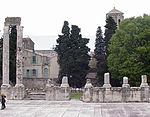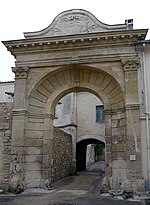Roman Theatre of Arles

The Roman Theatre of Arles is a 1st-century Roman theatre, built during the reign of Caesar Augustus. It is located next to the Arles Amphitheatre in the city of Arles, Provence, France. Along with the other Roman and medieval buildings in Arles, the theatre was listed on the UNESCO World Heritage List as part of the Arles, Roman and Romanesque Monuments site for their testimony to the ancient history of the city.In Roman times, the theatre had 33 rows of steps and could seat 8000 people. It is as large as the Roman Theatre of Orange, although much less well-preserved.During the Middle Ages, the theatre was used as a quarry, with the stone pillaged to build the city wall and other buildings. Today, only the stage area, orchestra section, seating rows, and two columns survive.The Venus of Arles, a famous Roman statue made of marble, was found in pieces at the Roman theatre in 1651.
Excerpt from the Wikipedia article Roman Theatre of Arles (License: CC BY-SA 3.0, Authors, Images).Roman Theatre of Arles
Rue de la Calade, Arles
Geographical coordinates (GPS) Address External links Nearby Places Show on map
Geographical coordinates (GPS)
| Latitude | Longitude |
|---|---|
| N 43.676389 ° | E 4.629722 ° |
Address
Théâtre antique
Rue de la Calade
13200 Arles
Provence-Alpes-Côte d'Azur, France
Open on Google Maps






